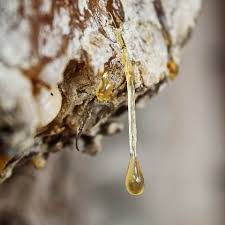Balsam Peru









Balsam Peru
Myroxylon balsamum var. pereirae
Family: Fabaceae (leguminosae)
Synonyms: Toluifera pereirae, Myrosperum pereirae, Myroxylon pereirae, Peruvian balsam, Indian balsam, black balsam.
General Description
A large tropical tree up to 25 metres high, with a straight smooth trunk, beautiful foliage and very fragrant flowers. Every part of the tree contains a resinous juice, including the fibrous fruit. The balsam is a pathological product, obtained from the exposed lacerated wood, after strips of the bark have been removed. It is a 'true' balsam, which is collected in the form of a dark brown or amber semi-solid mass.
Distribution
Native to Central America; production mainly takes place in San Salvador.
Other Species
Myroxylon frutescens and guina-guina are close relations, as well as Tolu balsam.
Herbal / Folk Tradition
It stimulates the heart, increases blood pressure, and lessons mucous secretions; useful for respiratory disorders such as asthma, chronic coughs and bronchitis. Traditionally employed for rheumatic pain and skin problems including scabies, nappy rash, bedsores, prurigo, eczema, sore nipples and wounds; it also destroys the itch acarus and its eggs.
Actions
Anti-inflammatory, antiseptic, balsamic, expectorant, parasiticide, stimulant, promotes the growth of epithelial cells.
Extraction
A resin-free essential oil is produced from the crude balsam by high vacuum dry distillation. (A wood oil is also produced by steam distillation from the wood chippings, which is considered of inferior quality. A white balsam called 'myrosocarpin' is made from the fruit, and an extract called ' balsamito' from the young fruit.)
Characteristics
The oil is a pale amber or brown viscous liquid with a rich, sweet, balsamic, 'vanilla-like' scent. It blends well with ylanbg ylang, patchouli, petitgrain, sandalwood, rose, spices, floral and oriental bases.
Principal Constituents
Benzonic and cinnamic acid esters such as benzyl benzonate, benzyl cinnamate and cinnamyl cinnamate as well as other traces. The crude balsam contains approximately 50-64 per cent oil, referred to a 'cinnamein', and 20-28 per cent resin.
Safety Data
Non-toxic, non-irritant; however the balsam (not the oil0 is a common contact allergen, which may cause dermatitis. Those who have this sensitivity may also react to benzoin resinoids; this is called 'cross sensitization.' The commercial oil is often a water-white liquid, being diluted with a solvent such as benzyl alcohol.
Aromatherapy / Home Use
Skin care: Dry and chapped skin, eczema, rashes, spores and wounds.
Circulation muscles and joints: Low blood pressure, rheumatism.
Respiratory System: Asthma, bronchitis, coughs.
Immune System: Colds
Nervous System: nervous tension, stress; like other balsams it has a warning, opening, comforting quality.
Other Uses
The balsam is extensively used in tropical medicinal preparations, and to some extent in pharmaceutical products; for example, cough syrup. Used as a fixative and fragrance component in soaps, detergents, creams, lotions and perfumes; the oil is often used in perfumery since this avoids any resin deposits or discolourations, used in most food categories, including alcoholic and soft drinks.
Reference: The Encyclopedia of Essential Oils: Julia Lawless
Articles Latest
- Chamomile Roman - Chamaemelum nobile
- Chamomile Maroc - Ormenis multicaulis
- Chamomile German - Matricaria recutica
- From Biology To Aromatherapy
- Plant Messengers
- Celery Seed-Apium graveolens
- Cedarwood Virginian - Juniperus virginiana
- Cedarwood, Texas- Juniperus ashei - Essential oils
- Cedarwood Atlas- Cedrus atlantica - Essential Oils
- Cassie - Acacia Farnesiana - sweet acacia
- Cassia - Cinnamomum Cassia
- Cascarilla Bark - Croton eluteria
- Carrot Seed- Dacus Carota
- CARDAMON
- CARAWAY
- CANANGA
- CAMPHOR
- CALAMUS
- Calamintha-Calamintha officinalis
- CAJEPUT- Melaleuca cajeputi
- Plant Expression
Articles-Most Read
- Home
- Balsam Canadian - Abies balsamea
- Balsam Peru
- Copaiba Essential Oil
- North America: Tea Tree and Monarda-3
- Basil French - Ocimum basilicum
- Basil Exotic
- North America: Tea Tree and Monarda-2
- Exploring Transcultural Constants
- Thyme Essential Oil
- Balsam Tolu
- Palma Rosa
- Bay - West Indian - Pimenta racemosa
- The Bioactivity of Essential Oils
- Benzoin - Styrax benzoin
- Why Pharmacology Cannot Demonstrate Essential Oil Efficacy
- Exploring Essential Oil Activity The Conventional Way
- Complex information From Plants
- Aromatherapy: An Answer
- Contacts
